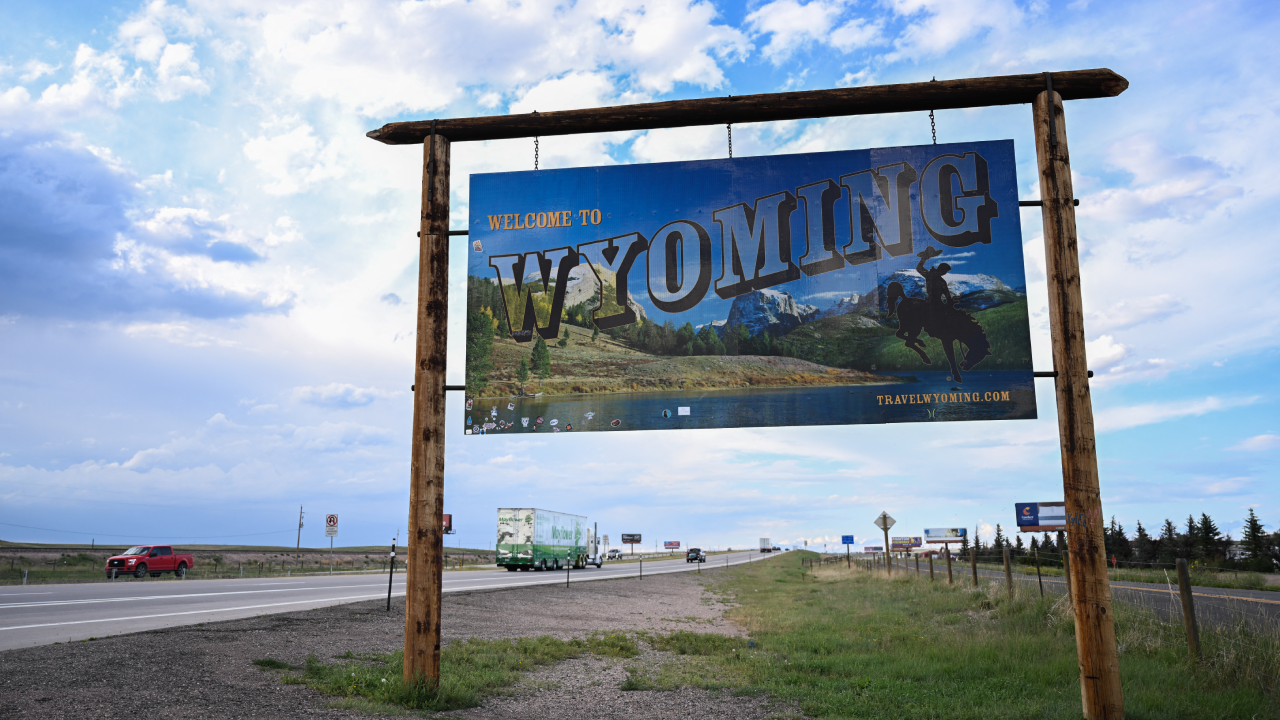These 9 states have no income tax — that doesn’t always mean you’ll save money

Key takeaways
- Nine states in the U.S. have no income tax: Alaska, Florida, Nevada, New Hampshire, South Dakota, Tennessee, Texas, Washington and Wyoming. (Washington does levy a long-term capital gains tax on high earners.)
- Moving to a state with no income tax may seem like a smart money move, but other factors such as cost of living, local taxes and job opportunities should also be considered.
- Tax experts advise looking at the whole picture and not basing your decision solely on taxes when deciding to move to a different state.
Burned by hot inflation and a steep cost of living over the past few years, many Americans have fled high-priced cities for more affordable places to call home.
One criterion some have used to select their new location: income taxes (or the lack thereof). Nine states exclude all or most of their residents’ income from taxation:
- Eight states charge no income tax at all: Alaska, Florida, Nevada, New Hampshire, South Dakota, Tennessee, Texas and Wyoming. (New Hampshire used to tax dividend and interest income, but repealed that tax effective Jan. 1, 2025.)
- Washington taxes long-term capital gains income for high earners. For any capital gains that exceed the state’s $270,000 standard deduction (that’s the amount for tax year 2024), you’ll face a 7 percent tax rate. But there are plenty of exceptions; for example, capital gains from real estate are excluded from this tax.
Income-tax-free Texas and Florida were the two most popular states where Americans moved in 2023, according to the most recent data on state migration patterns by the U.S. Census Bureau. Some 7.6 million people, or more than 2% of the U.S. population, moved in total.
But while moving to one of these tax-friendly states might seem like the ultimate way to reduce your expenses, you might not always save money in the long run.
For starters, states collect revenue through levies on more than just income, such as sales and property taxes. Plus, other considerations — including proximity to family as well as the local job and housing markets — may need to take precedence over taxation, tax preparers and wealth planners interviewed by Bankrate say.
“It’s nice not having taxes taken out of a paycheck, but you can’t look just at the income tax,” says Lisa Featherngill, senior vice president and national director of wealth planning at Comerica Wealth Management. “You have to look at the real estate tax, the sales tax, and then the other taxes that you’re going to pay to the state or county where you’re going to live.”
State taxes: It’s not just about income tax
Fully seven of the top 10 states on the Tax Foundation’s 2025 list of most competitive states for taxes are states that don’t levy an income tax. But there are some interesting anomalies:
- There are two no-income-tax states that aren’t on that “most competitive” list: Washington and Nevada. While Nevada is fairly close to the top at No. 17, Washington is at the other end of the Tax Foundation’s list, landing as one of the 10 least competitive tax states, partly because of its relatively high corporate and sales taxes.
- There are three states that do levy an income tax yet still landed in the top 10 for most-tax-competitive: Indiana, Montana and North Dakota. Read the Tax Foundation’s 2025 list of most tax-competitive states.
Taking a step back from taxes, a broader measure of affordability is overall cost of living. The Council for Community and Economic Research, or C2ER, looked at the 10 best states for cost of living, which includes taxes but also housing, utilities, health care and other costs.
Of the 10 states that win on C2ER’s cost-of-living measure, only one — Tennessee — is a no-income-tax state. Here is C2ER’s list of top 10 states for lowest cost of living: West Virginia, Oklahoma, Kansas, Mississippi, Arkansas, Alabama, Missouri, Iowa, Tennessee and Nebraska.
While many states that don’t have an income tax do have lower tax burdens, that’s not true for all no-income-tax states. Here’s what you need to know about the nine states with no income tax, including the competitiveness of each state’s tax structure, according to the Tax Foundation’s annual study.
Alaska
Alaska ranks third for tax competitiveness, according to the Tax Foundation, in large part because it has no income tax or state-level sales tax (local areas are still allowed to charge sales tax). However, its remote location can make the state a more expensive place to live, and it boasts one of the highest corporate tax rates in the country (a maximum of 9.4 percent).
- Overall rank (from most to least competitive out of 50): 3
- Property tax rank: 30
- Sales tax rank: 5
- Gas tax rank: 1
Florida
Florida is a popular tax and retirement haven, but high home prices and insurance costs have led to state-wide affordability constraints. In October, the median price of a single-family home in the state, for example, was $433,600, according to data from Redfin. That’s almost 8.8 percent higher than the national median for an existing home. In the absence of an income tax, the state relies on sales taxes and property taxes. Some household essentials, however, are excluded from taxation, such as groceries.
- Overall rank (from most to least competitive out of 50): 4
- Property tax rank: 21
- Sales tax rank: 14
- Gas tax rank: 39
Nevada
Nevada’s treasury collects much of its revenue from above-average sales taxes and fees. With a tourism-driven economy, however, out-of-state visitors may end up bearing the brunt of those costs.
- Overall rank (from most to least competitive out of 50): 17
- Property tax rank: 7
- Sales tax rank: 40
- Gas tax rank: 11
New Hampshire
New Hampshire doesn’t tax wage income and it has no sales tax. Through tax year 2024 it collected taxes on interest and dividend income, but the state ended that tax effective January 2025. Meanwhile, the state has one of the highest property tax rates in the country (1.61 percent).
- Overall rank (from most to least competitive out of 50): 6
- Property tax rank: 39
- Sales tax rank: 1
- Gas tax rank: 12
South Dakota
Not only does South Dakota not collect income taxes, but its state sales tax rate is 4.2 percent, among the lowest in the country. But municipalities can collect another 1 to 2 percent on top of that, capping off the combined state and average local sales tax rate at 6.11 percent.
- Overall rank (from most to least competitive out of 50): 2
- Property tax rank: 10
- Sales tax rank: 31
- Gas tax rank: 26
Tennessee
Tennessee residents don’t have to pay state taxes on their wages. The Volunteer State used to tax dividends and interest in a levy known as the “Hall Tax,” but that was phased out for the 2022 tax year. However, Tennessee has one of the highest state and local sales tax rates in the country at a combined 9.55 percent.
- Overall rank (from most to least competitive out of 50): 3
- Property tax rank: 33
- Sales tax rank: 47
- Gas tax rank: 20
Texas
Texas doesn’t have an income tax, but it does levy a state sales tax of 6.25 percent. Local jurisdictions can levy up to 1.95 percent in additional taxes, for a combined rate of 8.2 percent. Texas also has a high property tax rate of 1.47 percent.
- Overall rank (from most to least competitive out of 50): 7
- Property tax rank: 40
- Sales tax rank: 36
- Gas tax rank: 7
Washington
Washington doesn’t charge an income tax, but it levies a 7 percent tax on capital gains for high earners (taxpayers can exclude up to $270,000 in gains for tax year 2024; that standard deduction adjusts for inflation each year). A 6.5 percent state sales tax combined with the average local sales tax rate results in a combined tax of 9.38 percent. Washington also has the third-highest median single-family home price in the country, at $658,700, 65 percent higher than the nationwide median price for an existing home.
- Overall rank (from most to least competitive out of 50): 45
- Property tax rank: 25
- Sales tax rank: 50
- Gas tax rank: 47
Wyoming
In addition to not charging an income tax, Wyoming doesn’t charge corporate levies, nor estate or inheritance taxes, making it the most tax competitive state in the U.S. It has a 4 percent sales tax and an average local sales tax of 1.44 percent, for a combined state and local tax rate of 5.44 percent.
- Overall rank (from most to least competitive out of 50): 1
- Property tax rank: 44
- Sales tax rank: 7
- Gas tax rank: 13
Should you move to a state with no income tax?
Mark Steber, chief tax information officer at Jackson Hewitt, moved to a state without an income tax: Florida. Initially, he liked the extra 3 to 4 percent per paycheck. He also enjoyed paying less for gas and saving on groceries. Then, his car and home insurance came due.

“I thought, ‘Great goodness, what the heck?’” Steber says. “Income taxes are your largest single financial transaction each and every year, so it’s an important factor to pay attention to, but it’s not the one deciding factor if you’re making good decisions. Taxes never work the way you think they will.”
If you’re trying to determine whether moving to a state with no income tax is financially worth it, start by taking a look at your most recent tax return. Calculate how much you paid in state income taxes (some states have a flat rate, while others have a graduated rate) and determine your effective income tax rate. Then, compare that total with what you would be paying in the state where you wish to move.
Typically, higher-income earners and retirees can stand to save, Featherngill says. She’s also seen clients consider timing a move to a lower-tax state with a major financial event, such as selling a business or an asset.
But taxation never gives you the full picture, both Steber and Featherngill say. Compare the property tax and sales tax rates of both locations, along with cost-of-living considerations, such as housing and food. Moving costs or locking in a new mortgage in a high-rate era can also add up.
“If property taxes are so high on my house and I have to move and buy something, that might be more expensive, and I might not be in as good a situation as I think,” Featherngill says. “The personal issues become as dominant as the tax issues.”
Family considerations might matter as well. Road trips and plane tickets can quickly add up if you’ll be traveling home to visit loved ones.
Steber, who moved solely because he was transferred for work, also recommends looking into the local job market. If you lose a job and your local area doesn’t have many gigs in your industry, it might be harder to find new work.
“If someone says to me, ‘I’m moving to Texas. It’s free income down there.’ I say, ‘Well, how are you going to live? Are you going to work?’” Steber says. “No income tax can quickly be offset by no job.”
Bottom line
If you’re a retiree, a high-income earner or living in a state that has a high cost-of-living and tax burden, you might stand to save by moving to a tax-friendly state, though be wary about making taxes the sole reason for your move.
“You have to look at the whole picture,” Steber says. “Start with your own simple analysis and have a tax pro kick the tires. Taxes are simply never a reason to make a total financial decision.”
Why we ask for feedback Your feedback helps us improve our content and services. It takes less than a minute to complete.
Your responses are anonymous and will only be used for improving our website.






